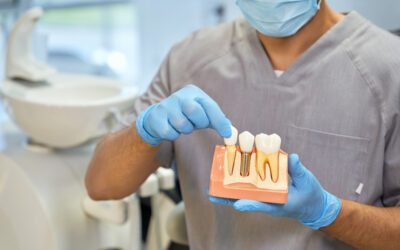What is Endodontics?
Endodontics is a specialized dental field that focuses on diagnosing, treating, and preventing issues related to the dental pulp and surrounding tissues.
The dental pulp is the soft tissue at the center of a tooth, containing nerves, blood and lymphatic vessels, and connective tissue. The term “endodontics” itself is derived from the Greek words “endo,” which means “inside,” and “odont,” which means “tooth.” As a result, endodontists play a crucial role in maintaining the health and integrity of our teeth from the inside out.
Endodontists undergo additional specialized training after dental school to help them effectively diagnose and treat tooth pain, infections, and diseases. This expertise allows them to perform advanced procedures such as root canals, which aim to save a broken or infected tooth by removing the inflamed or infected pulp and sealing it to prevent further damage.
Their unique skill set enables them to provide accurate diagnoses and develop effective treatment plans to help patients find relief from tooth pain and preserve their natural teeth.
One of the primary responsibilities of endodontists is managing complex dental issues that general dentists may be unable to address. This includes addressing tooth pain, performing root canals, and handling other specialized treatments required to preserve and protect a patient's dental health.
Overall, endodontics plays an essential role in modern dentistry, as endodontists help maintain healthy teeth and provide crucial treatments for patients suffering from dental pain and disease.
History and Evolution of Endodontics
Endodontics had its roots (no pun intended!) in the late 1700s and early 1800s when different treatment modalities were practiced. A significant milestone in the field's development occurred in 1838 when Edwin Maynard designed the first instrument specifically for endodontic therapy.
The field continued to evolve as endodontists started preserving teeth that had failed to respond to non-surgical endodontic treatment or developed new lesions through procedures such as root canal re-treatment and periradicular surgery.
Throughout the 19th and early 20th centuries, dental practitioners developed new techniques to improve endodontic treatments. One of these approaches was the semilunar incision on the buccal mucosa, introduced by Partsch in the late 1800s.
In more recent years, the focus of endodontics has shifted to understanding the relationship between systemic diseases and the pathogenesis of apical periodontitis (AP), as well as how these diseases might interfere with the repair of periapical tissues after endodontic treatment.
Importance of Endodontics
The dental pulp is the soft tissue in the tooth's center, containing nerves, blood vessels, and connective tissue. It is a crucial branch of dentistry, as it works to preserve the function and structure of natural teeth that might otherwise be lost due to decay or injury.
One of the primary reasons endodontics is so essential is because it helps to relieve tooth pain associated with infections or damage to the pulp.
Untreated pulp infections can cause severe pain and even spread to surrounding tissues, leading to additional dental problems. By focusing on the health and preservation of the dental pulp, endodontists work to alleviate pain and maintain healthy teeth.
Another significant aspect of endodontics is its role in saving natural teeth.
Whenever possible, preserving the natural tooth structure is always the best course of action, as it helps maintain the mouth's functionality and appearance. Endodontists are skilled in performing intricate procedures such as root canals, which remove the infected pulp and help save the tooth from extraction.
Endodontics has evolved, incorporating new techniques and tools to enhance patient comfort and treatment outcomes.
These advancements have made endodontic procedures more effective and improved patient experiences, making the treatments more tolerable for those who might otherwise avoid essential dental care.
What is Endodontics? – An Overview of Procedures
Root Canal Treatment
A root canal treatment is a standard endodontic procedure involving the removal of the infected or damaged dental pulp.
According to the American Association of Endodontists, this treatment is often required when the pulp in the tooth becomes inflamed or infected due to deep decay, repeated procedures on the tooth, or injury to the tooth.
During a root canal, the endodontist will remove the diseased pulp, clean and shape the root canal system, and then fill and seal the space to prevent further infection.
Finally, they will restore the tooth with a filling or crown.
Endodontic Retreatment
Sometimes, a tooth undergoing root canal treatment may not heal or develop new problems, necessitating endodontic retreatment.
Endodontic retreatment is performed to save the tooth. It involves removing the existing tooth filling or crown, accessing the root canal system, cleaning and shaping the canals, and sealing the space with the new filling material.
Endodontic Surgery
Endodontic surgery may be recommended if a nonsurgical root canal cannot save the tooth.
The most frequent type of endodontic surgery is an apicoectomy, which involves the removal of the root tip (apex) and surrounding infected tissue, followed by sealing the root end with a small filling.
Other less common endodontic surgeries include intentional replantation, where a tooth is extracted, treated outside the mouth, and then replanted, and root amputation, where a single root of a multi-rooted tooth is removed due to infection or damage.
Technological Advances in Endodontics
One of the key advancements in endodontics is the adoption of digital planning and guided technology.
These tools allow for better visualization of complex root canal anatomies, enabling more accurate diagnosis and treatment planning. Cone Beam Computed Tomography (CBCT) imaging has also revolutionized endodontic diagnostics, providing high-resolution 3D images of teeth and surrounding structures.
Another significant advancement is the development of new instrumentation techniques for root canal treatment. Nickel-Titanium (NiTi) rotary files have vastly improved the efficiency, precision, and flexibility in cleaning and shaping the root canal system. Furthermore, ultrasonic tips enhance the effectiveness of various endodontic procedures, including root-end cavity preparations and post-removal.
Improved irrigation techniques have also contributed to better endodontic outcomes. Introducing irrigants such as sodium hypochlorite, chlorhexidine, and ethylenediaminetetraacetic acid (EDTA) has resulted in more effective disinfection of the root canal system by eliminating bacteria and dissolving organic tissues.
Novel techniques like passive ultrasonic irrigation, sonic activation, and apical negative pressure systems have improved the delivery of irrigants to the most challenging areas of the root canal system.
Further, advances in endodontic surgery have led to more predictable outcomes and reduced procedure risks.
Innovations such as using microsurgical techniques and operating microscopes, together with applying biocompatible materials like Mineral Trioxide Aggregate (MTA) cement, have improved post-operative healing and overall success rates.
Endodontics has benefited enormously from various technological advancements. These innovations have enhanced the accuracy of diagnosis, the efficiency of treatment procedures, and the overall patient experience. As research and technology progress, endodontics will evolve further, paving the way for even better patient care and outcomes.
How to Choose an Endodontist
When selecting an endodontist, it is crucial to consider their level of experience and expertise. A well-established practitioner with years of experience is more likely to provide you with the highest quality care, as they have performed numerous procedures throughout their career.
Another essential factor is the endodontist's equipment and surgical technology. Modern, advanced tools can significantly improve the overall experience and effectiveness of the treatment. You may also want to inquire about the endodontist's specific training and any additional certifications they have acquired to ensure they are well-versed in the latest endodontic techniques.
Getting recommendations from friends, family, or your general dentist can also be invaluable when choosing an endodontist. The referral should be based on their expertise (being a patient in Endodontic procedures) and the quality of care they provide.
Researching patient reviews and testimonials can offer insight into their practice and help you gauge other patients' experiences, giving you a better understanding of what to expect during your treatment.
Lastly, consider the endodontist's availability, location, and office hours. It can be essential to select a conveniently located practitioner with suitable hours to accommodate your schedule, making it easier for you to attend appointments and receive treatment.
Tips for Maintaining Your Endodontic Health
Maintaining good endodontic health is essential for preserving natural teeth and improving oral hygiene. Here are a few tips to help you maintain optimal endodontic health:
Daily Oral Hygiene: Make sure to brush your teeth at least twice daily, preferably in the morning and before bed, with a soft-bristled toothbrush. Additionally, use fluoride toothpaste and floss daily to remove food pieces and plaque between your teeth and under your gum line. This helps prevent tooth decay and gum disease that could potentially lead to endodontic issues.
Regular Dental Check-ups: Visit your dentist for regular check-ups and cleanings every six months or as your dental professional recommends. Regular dental visits can identify potential endodontic issues early and increase the likelihood of successful treatment.
Avoid Chewing Hard Foods: Eating hard foods, such as ice or hard candies, can cause tooth fractures or damage to existing dental restorations, which may necessitate endodontic treatment. Instead, opt for softer foods and be cautious while chewing to prevent injury to your teeth.
Wear a Mouthguard: If you participate in contact sports or tend to grind your teeth at night, wearing a custom-made mouthguard can help protect your teeth from fractures and other injuries. Such precautions can prevent the need for endodontic treatments in the future.

Affordable Custom Nightguards
Educate Yourself on Endodontic Procedures: If you require endodontic treatment such as a root canal, it is essential to be well-informed about the procedure and understand its benefits. The American Association of Endodontists provides detailed information on various endodontic treatments and procedures, which can help you make informed decisions about your dental care.
Following these tips and maintaining proper oral hygiene can effectively preserve your natural teeth and ensure optimal endodontic health.
What is Endodontics? Final Thoughts.
What is Endodontics?
Endodontics is a specialized dental field that treats dental pulp and surrounding tissues. This branch of dentistry aims to preserve natural teeth by diagnosing and treating complex issues within the tooth's interior, such as inflammation or infection of the pulp.
Root canals don't have to be scary. Endodontists focus on relieving tooth pain. You will feel better taking care of the problem instead of avoiding it.
Need an Endodontist? Search the directory and find one near you.




